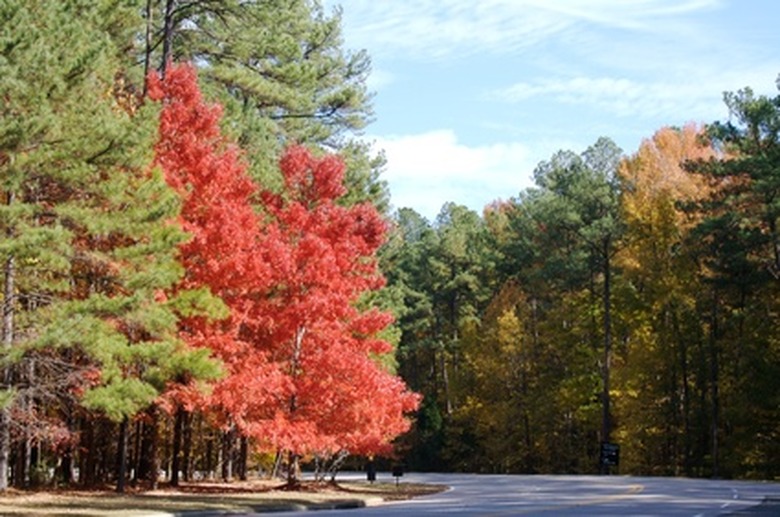North Carolina Tree Leaf Identification
North Carolina's native trees reflect the widely varying terrain of the state. Trees growing along the coastal plains are adapted to sandy, salty conditions. The mild climate and rolling foothills of the Piedmont region produce trees typically seen in temperate zones, such as crab apples, elms, ashes and wild plums. Pines, maples, oaks and other large trees are found throughout the western part of the state and the mountainous Smoky Mountain and Blue Ridge areas.
Time Frame
Many North Carolina trees are deciduous and lose their leaves in the fall. American beech (Fagus grandifolia), nutmeg hickory (Carya myristicaeformis), American elm (Ulmus Americana) and red maple (Acer rubrum) are just a few of the native North Carolina trees that lose leaves in the fall.
Many trees are evergreen in North Carolina's mild climate. Broad-leaved evergreens such as loblolly bay (Gordonia lasianthus), American holly (Ilex opaca) and Carolina cherry laurel (Ilex opaca) keep their green, glossy leaves year-round.
- North Carolina's native trees reflect the widely varying terrain of the state.
- Many trees are evergreen in North Carolina's mild climate.
Atlantic white cedar (Chamaecyparis thyoides) and Eastern white pine (Pinus strobus) are two examples of needle-leaved evergreens native to North Carolina.
Leaf Shape
When identifying North Carolina tree leaves, consider the shape of the leaves. Shumardi red oak (Quercus schumardii) and sugar maple (Acer saccharum) have the deeply cut leaf shapes commonly associated with their species. The evergreen leaves of the Southern magnolia (Magnolia grandiflora) are glossy, deep-green, elongated ovals with brown undersides. The leaves of the wild olive or devilwood (Osmanthus americanus) are also evergreen and glossy, but smaller than those of the magnolia.
Leaf Color
Consider the color of the foliage when identifying trees native to North Carolina. Ironwood (Carpinus caroliniana), maples and oaks are known for brilliant fall foliage. The blue-green, thread-like leaves of the pond cypress are held upright, and turn orange, yellow and red in the fall. New foliage on devil's walking stick emerges bronze. The needle-like foliage of the Carolina hemlock have white strips on the underneath portion.
- Atlantic white cedar (Chamaecyparis thyoides) and Eastern white pine (Pinus strobus) are two examples of needle-leaved evergreens native to North Carolina.
- The leaves of the wild olive or devilwood (Osmanthus americanus) are also evergreen and glossy, but smaller than those of the magnolia.
Unusual Characteristics
When identifying the leaves of North Carolina trees, consider unusual characteristics. The elongated leaves of the paw paw (Asimina triloba) have an unpleasant odor when crushed, while the leaves of the Carolina cherry laurel are toxic to livestock and people.
Other Identifying Characteristics
In addition to the leaves, many North Carolina trees have interesting flowers, fruits or bark that identify them. The spice bush (Lindera benzoin) produces leaves, bark and flowers with a spicy scent, followed by bright red fruits. American plum (Prunus Americana), persimmon (Diospyros virginiana), and paw paw (Asimina triloba) produce edible fruit. Hickory, walnut and buckeye species produce nuts.
